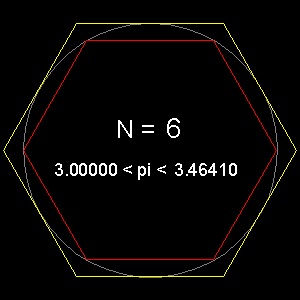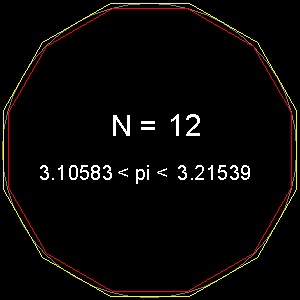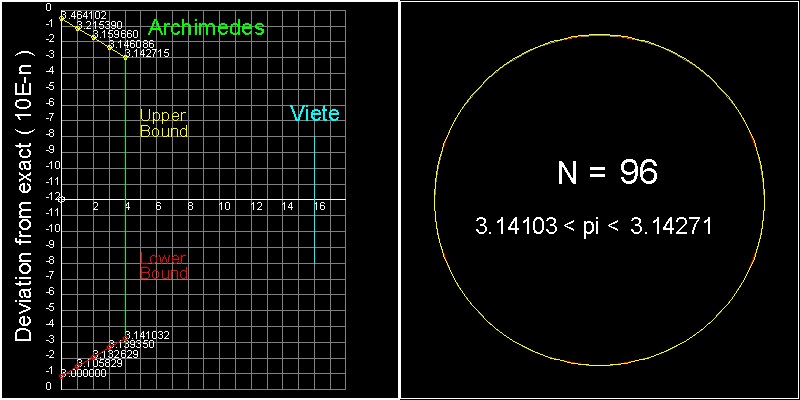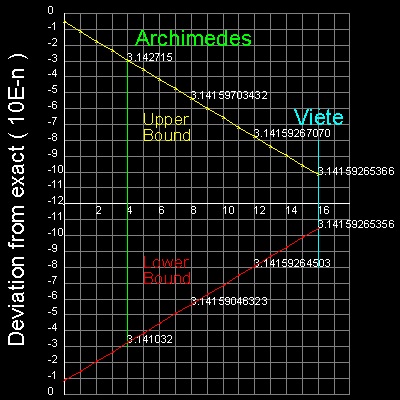

********* pi_hexagon.dwg ********* ********** pi_12gon.dwg *********
Archimedes (287BC - 212 BC) was the first to give a method of calculating p to any desired degree of accuracy.
His method is based on the fact that the perimeters of the polygons inscribed in a circle and circumscribed about the same circle give lower and upper bound values,respectively, for the circle's circumference.
Examples for hexagon and dodecagon are shown below.


********* pi_hexagon.dwg *********
********** pi_12gon.dwg *********
In these drawings, the diameter is set to 10. So after opening the drawings, look at the values of perimeter.
(Use either "LIST" command or "Properties" option.)
One tenth (1/10) of the perimeter is the approximation for p .
He increased the number of sides for the polygon up to 96(k = 4), and obtained the following result.
3 (10/71) < p < 3 (1/7)
or in decimal,
3.14084 <p < 3.142858
This is an amazing feat considering that computation was done using ratio's(for example square root 3 was
replaced by 265/153, etc) and trigonometry was invented 1000 years after his time.

******************************** Archimedes_96_gon.dwg ********************************
You can see the process in animation.
To create this drawing and animation:
Load pi_approximation.lsp (load "pi_approximation")
Then from command line, type Archimedes_pi

You can see the process in animation.
To create this drawing and animation:
Load pi_approximation.lsp (load "pi_approximation")
Then from command line, type List_pi_number
Then input 17 for repeat cycles.
Note: x axis is linear with integer k, and y axis is logarithm with base 10.
For every 4 increment of k, the upper and lower bound values are displayed.
Some readers must have noticed that the lines of upper and lower bounds look straight lines with the same gradient.
That is the right observation and the explanation will be given below.
**************** Viete_pi.dwg ****************
Maclaurin series for sinx and tanx are
sinx = x - x3/3! + x5/5! - .... (1)
tanx = x + (1/3)x3 + (2/15)x5 + .... (2)
Lower bound (LB) and upper bound (UB) are
LB = 6(2)k sin((p/6)/2k)
UB = 6(2)k tan((p/6)/2k)
Using the first 2 terms in (1) & (2), LB and UB becomes
LB = p[1 -(1/6)(p/6)2(2)-2k]
UB = p[1 +(1/3)(p/6)2(2)-2k]
Next we define the deviation of LB and UB from the exact value of p as follows:
Fl = p - LB
Fu = UB - p
Then
Fl = (p/6)3 2-2k
Fu = 2(p/6)3 2-2k
Taking logarithm of both sides
log(Fl) = log(p/6)3 - (2log2)k (3)
log(Fu) = log{2(p/6)3} - (2log2)k (4)
(3) ,(4) are the line equation of type y = a + bk
where b is the slope, and a is the y-value when k = 0.
|
Summary of p value using the idea of inscribed & circumscribed polygons Name No. of sides of Polygon Correct to Archimedes (287BC - 212BC) 96 3.14 Fibonacci (1170 - 1250) 96 3.141 Viète (1540 - 1603) 6 X 216 10-th decimal place Roomen (1561 - 1615) 230 16-th decimal place Ludolph (1540 - 1610) 262 35-th decimal place |
All questions/suggestions should be sent to Takaya Iwamoto
Last Updated Nov 22, 2006
Copyright 2006 Takaya Iwamoto All rights reserved.